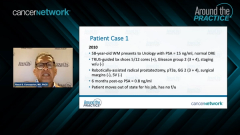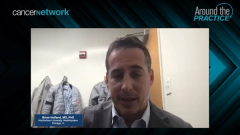
Considerations for Tracer Selection to Assess Biochemical Recurrence in Prostate Cancer
Munir Ghesani, MD, an expert in nuclear medicine, describes the factors that differentiate available tracers and provides guidance on tracer selection.
Episodes in this series

Raoul S. Concepcion, MD, FACS: Dr Ghesani, educate us. You deal with this a lot, and you understand. You have a tracer, and then there are nuances to this based on half-life. Gallium has a particular half-life, and F-18 [fluorine-18] has a particular half-life. Obviously, choline has a particular half-life. How does that impact and how does that play out potentially, as these scans are made more available to the general practitioner, the community urologist and oncologist? What are the factors there that the practitioners need to know that are the nuanced differences between those tracers?
Munir Ghesani, MD: I would like to make 2 more points that I just started thinking about as Brian and Judd mentioned those items. I would like to add on those as well. As Brian referenced, there are data that show there’s less than 20% sensitivity for combination of bone scans and CT [computerized tomography] scans in the setting of biochemical recurrence. There’s even a bigger problem, which is that in the small minority of the patients where the scans pick up the disease, it’s misleading because it does not fully clarify the extent of disease. Therefore, if you superficially look at it, you will see about 20% or less benefit. But in fact, even a subgroup of those patients does not benefit because their disease has not been properly delineated. They may have disease that was picked up only in part by the CT and bone scans, and you may end up targeting your treatment and not recognizing that there may be disease outside what the CT and bone scan did not pick up.
For that reason, it will be important to work with the CMS [Centers for Medicare & Medicaid Services] and other providers, and we are aggressively working in various societies by collaborating with one another to make these points clear. Hopefully, soon, these requirements for bone scans and CT scans will not be there. The second point I wanted to mention was in that polling question, the item about other, and this brings back to your question about all different options. There is also fluorine-18 FDG [fluorodeoxyglucose], which is the most used agent for most other cancers. It has been shown that for most cancers in the prostate it does not work, but with a very high Gleason score, they have very high level of glucose metabolism. Therefore, in a select and small subgroup of patients who have known to have a very high Gleason score, when they recur, one should also consider the possibility of FDG PET [positron emission tomography scan] or CT because in that subgroup, it is going to be very powerful.
Regarding your question about how we should choose. At the current level, the fluorine-18 half-life of 2 hours is readily available all around. It will be easy for the sides. Even after bone scan and CT scans have been negative, you have gone through the peer-to-peer and have an approval of fluciclovine, which would be the most used agent across the country at this time. For those sites that have the availability of gallium PSMA [prostate-specific membrane antigen] through the cross-referencing IND [investigational new drug] or clinical trials, but those would be mostly major academic centers. They can consider using gallium or fluorine PSMA-based agents. For small sites—the Mayo Clinic, for example—where the C-11 choline was first developed, they can with cyclotron availability produce in a large batch, and we know that sites like the Mayo Clinic are doing a large number of carbon-11 PSMA scans.
Raoul S. Concepcion, MD, FACS: That is a limitation, isn’t it? The half-life of the C-11 is so short that they can’t…
Munir Ghesani, MD: It’s 20 minutes.
Raoul S. Concepcion, MD, FACS: You can’t ship it a distance. To any of you, we know that fluciclovine Axumin is approved. It is approved in patients who have been treated for prostate cancer and have a rising PSA [prostate-specific antigen]. Correct me if I’m wrong, but doesn’t that include patients on active surveillance whose PSA [is rising]? Can you make the argument that active surveillance is a treatment and if they have a rising PSA, you could get fluciclovine? Have any of you tried that?
Brian Helfand, MD, PhD: You can make that argument. I don’t think it’s correct. I’ve seen it done, and it’s not really the FDA indication. What they mean is that interventions with curative intent, or subsequent hormone therapy that the patient is progressing. However, active surveillance was not part of that initial approval indication. Having said that, in the world many things are done whether there’s evidence or not evidence for that. Therefore, we don’t generally monitor our active surveillance patients with that.
Raoul S. Concepcion, MD, FACS: Perfect.
Transcript edited for clarity.
Newsletter
Stay up to date on recent advances in the multidisciplinary approach to cancer.



























































































